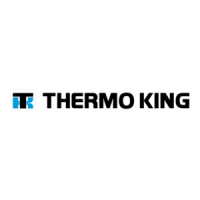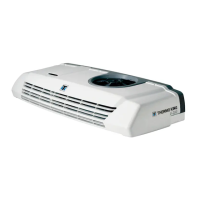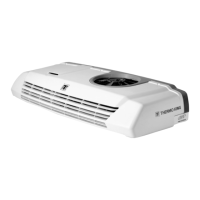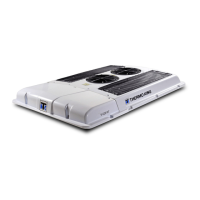Do you have a question about the Thermo King V-200 and is the answer not in the manual?
Details the terms of software usage for the Thermo King product.
Provides contact information and required details for breakdown assistance.
Directs users to local dealers for inquiries and maintenance information.
Explains hazard indicators and their meanings for user safety.
Outlines essential safety guidelines for operating and servicing the unit.
Warns about the unit's automatic start capability and safety measures.
Details hazards associated with battery installation and cable management.
Covers safety precautions related to handling hazardous refrigerant gases.
Provides safety advice and PPE requirements for handling refrigerant oil.
Offers first aid instructions for exposure to refrigerants, oil, coolants, and battery acid.
Explains the purpose and meaning of various safety decals on the unit.
Describes the common components and design aspects of the units.
Lists available optional features and configurations for the units.
Identifies the main components of the Thermo King refrigeration system.
Details the types of compressors used in vehicle-powered and electric standby models.
Explains the location and accessibility of the condenser unit.
Describes the mounting location and serviceability of the evaporator.
Introduces the electronic control module and its functions.
Explains the HMI display, keys, and symbols for unit operation.
Details how to operate the unit in electric standby mode.
Covers the unit's electrical components and power requirements.
Lists the location and types of fuses protecting the unit's electrical components.
Explains the basic modes of operation (cool, heat, null, defrost).
Provides step-by-step instructions for starting the unit via engine or electric standby.
Describes the standard display screen and its information.
Shows an example display for single-temperature unit operation.
Shows an example display for multi-temperature unit operation.
Guides users on how to change the temperature setpoint.
Explains how to select active compartments for multi-temperature units.
Provides steps to manually start an evaporator defrost cycle.
Guides on manually initiating a condenser defrost cycle.
Describes the unit's alarm system and categories.
Explains when the unit's buzzers are activated.
Lists and explains various DSR alarm codes and their meanings.
Details the procedure for clearing alarm codes after resolving issues.
Explains how to access main menu and hourmeter information screens.
Outlines checks to perform after starting the unit, including pre-cooling.
Provides instructions for loading products to maintain temperature and minimize frost.
Details actions to take after loading, such as closing doors and setting thermostat.
Details specifications for various compressor models.
General information regarding the refrigeration system.
Information on the unit's electrical control system.
Lists common and model-specific fuse ratings and locations.
Technical specifications for condenser fan motors.
Technical specifications for evaporator fan motors.
Specifications for the unit's transformer.
Specifications for electric motors used in Model 50.
Details of the tracking system hardware and software.
Information on Bluetooth connectivity.
Details on available serial ports for extensions.
Specifies the input power requirements.
Information on the backup battery.
Specifies the environmental storage temperature range.
Lists routine checks to perform before unit operation.
Details important weekly checks for preventative maintenance.
Outlines checks to perform after the unit has completed its operation.
Information on scheduled maintenance based on operating hours.
Guidance on recording inspection and service activities.
Procedure for presenting the unit for warranty verification.
Recommendations for daily/weekly maintenance tasks.
Details the terms of software usage for the Thermo King product.
Provides contact information and required details for breakdown assistance.
Directs users to local dealers for inquiries and maintenance information.
Explains hazard indicators and their meanings for user safety.
Outlines essential safety guidelines for operating and servicing the unit.
Warns about the unit's automatic start capability and safety measures.
Details hazards associated with battery installation and cable management.
Covers safety precautions related to handling hazardous refrigerant gases.
Provides safety advice and PPE requirements for handling refrigerant oil.
Offers first aid instructions for exposure to refrigerants, oil, coolants, and battery acid.
Explains the purpose and meaning of various safety decals on the unit.
Describes the common components and design aspects of the units.
Lists available optional features and configurations for the units.
Identifies the main components of the Thermo King refrigeration system.
Details the types of compressors used in vehicle-powered and electric standby models.
Explains the location and accessibility of the condenser unit.
Describes the mounting location and serviceability of the evaporator.
Introduces the electronic control module and its functions.
Explains the HMI display, keys, and symbols for unit operation.
Details how to operate the unit in electric standby mode.
Covers the unit's electrical components and power requirements.
Lists the location and types of fuses protecting the unit's electrical components.
Explains the basic modes of operation (cool, heat, null, defrost).
Provides step-by-step instructions for starting the unit via engine or electric standby.
Describes the standard display screen and its information.
Shows an example display for single-temperature unit operation.
Shows an example display for multi-temperature unit operation.
Guides users on how to change the temperature setpoint.
Explains how to select active compartments for multi-temperature units.
Provides steps to manually start an evaporator defrost cycle.
Guides on manually initiating a condenser defrost cycle.
Describes the unit's alarm system and categories.
Explains when the unit's buzzers are activated.
Lists and explains various DSR alarm codes and their meanings.
Details the procedure for clearing alarm codes after resolving issues.
Explains how to access main menu and hourmeter information screens.
Outlines checks to perform after starting the unit, including pre-cooling.
Provides instructions for loading products to maintain temperature and minimize frost.
Details actions to take after loading, such as closing doors and setting thermostat.
Details specifications for various compressor models.
General information regarding the refrigeration system.
Information on the unit's electrical control system.
Lists common and model-specific fuse ratings and locations.
Technical specifications for condenser fan motors.
Technical specifications for evaporator fan motors.
Specifications for the unit's transformer.
Specifications for electric motors used in Model 50.
Details of the tracking system hardware and software.
Information on Bluetooth connectivity.
Details on available serial ports for extensions.
Specifies the input power requirements.
Information on the backup battery.
Specifies the environmental storage temperature range.
Lists routine checks to perform before unit operation.
Details important weekly checks for preventative maintenance.
Outlines checks to perform after the unit has completed its operation.
Information on scheduled maintenance based on operating hours.
Guidance on recording inspection and service activities.
Procedure for presenting the unit for warranty verification.
Recommendations for daily/weekly maintenance tasks.
| Brand | Thermo King |
|---|---|
| Model | V-200 |
| Category | Automobile Accessories |
| Language | English |











